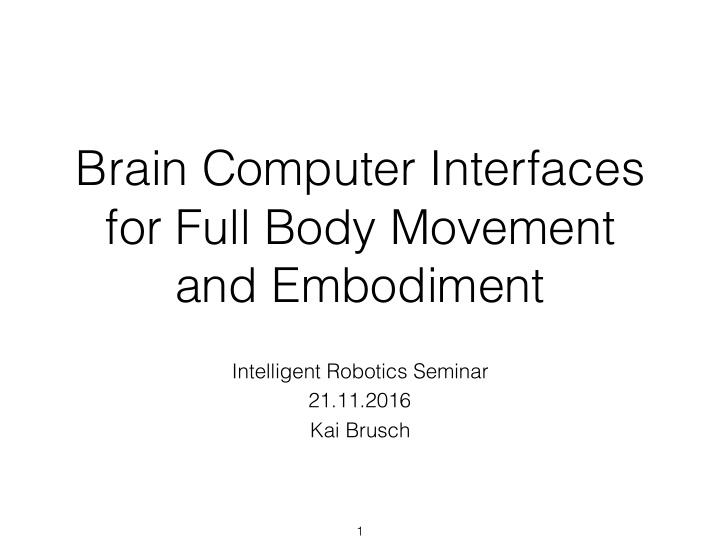



Brain Computer Interfaces for Full Body Movement and Embodiment Intelligent Robotics Seminar 21.11.2016 Kai Brusch 1
Brain Computer Interfaces for Full Body Movement and Embodiment Intelligent Robotics Seminar 21.11.2016 Kai Brusch 2
Brain Computer Interfaces for Full Body Movement and Embodiment Intelligent Robotics Seminar 21.11.2016 Kai Brusch 3
Brain Computer Interfaces for Full Body Movement and Embodiment Intelligent Robotics Seminar 21.11.2016 Kai Brusch 4
Brain Computer Interfaces for Full Body Movement and Embodiment 5
Full Body Movement and Embodiment [4,5,6] 6
Electroencephalography (EEG) + Electrophysiological monitoring method + Non-invasive + openbci.com [1] 7
Electroencephalography (EEG) + Segmentation into electrodes + Signal needs to penetrate skull + Mapping to region is inaccurate [2] 8
Electrocorticography (EGOC) + Invasive Implant + EEG direct on the cerebral cortex + Implant located on the region of interest [2] 9
Electrocorticography (EGOC) + Lower Noise vs Signal ratio + Higher Spatial resolution + Direct mapping from signal to brain region [2] 10
Functional Magnetic Resonance Imaging (f-MRI) + Stationary + Expensive machine + Non-invasive [3] 11
Functional Magnetic Resonance Imaging (f-MRI) + Hemodynamic response + Oxygen consumption + Image data [9] 12
Compare and Contrast EEG ECOG f-MRI Non invasive Invasive Non invasive High Temporal High Temporal Low Temporal Low Spatial High Spatial High Spatial High Noise Low Noise High Noise Cheap Expensive Expensive 13
Compare and Contrast EEG ECOG f-MRI Non invasive Invasive Non invasive High Temporal High Temporal Low Temporal Low Spatial High Spatial High Spatial High Noise Low Noise High Noise Cheap Expensive Expensive 14
Brain Computer Interfaces for Full Body Movement and Embodiment 15
Can M and K learn to navigate in a 2D space? + BCI have been established for limb movement [12] + Whole body navigation has been untested [10] + Chronically implanted with multichannel electrode arrays (EGOC) on two monkeys (M,K) 16
Experiment Setup I 17 [10]
Experiment Setup II [10] 18
Classifier Training Method + 30 trials to train BCI decoder + Passive movements evoke somatosensory sensations + Generated commands from a 1s window divided into ten 100 ms bins [10] 19
Classifier Training Course [10] 20
Experiment Findings I + 1D Navigation + Translational (Forward, Backward) + 2D Navigation + Translational (Forward, Backward) + Rotational (leftward or rightward [10] 21
Experiment Findings II [10] 22
Video https://www.youtube.com/watch?v=zPTvHG7XNxM 23
Whole Body Movement Findings + Cortical neuronal ensembles can directly control whole ‐ body navigation in a mobile device such as a robotic wheelchair. [10] + Did the monkey really wanted to go there? + How much navigation was involved? 24
Brain Computer Interfaces for Full Body Movement and Embodiment 25
Can a BCI create the illusion of being somewhere else? + f-MRI computer brain interface with virtual feedback. + The subject is given the illusion of being embodied in an avatar. + Navigation only through screen and thought. 26
Classifier Training I [11] 27
Classifier Training II [11] 28
Classifier Training III [11] 29
Classifier Training III [11] 30
Video https://www.youtube.com/watch?v=cXFmRzNZHqc&t=182s 31
Embodiment Findings + Subjects are able to perform a navigation task in a virtual environment using an fMRI-based BCI. + Test subject reported a ‘feeling of being in France’. + Tapping with finger appears the best approach to directing movement. 32
Conclusion + Basic capabilities for embodiment and full body movement + Subjects had the feeling of being embodied ‘in France’ + Ethical questions arise naturally 33
34 [13]
References [1] http://openbci.com/ [2] https://en.wikipedia.org/wiki/Electrocorticography#/media/ File:Intracranial_electrode_grid_for_electrocorticography.png [3] http://sites.psu.edu/siowfa15/wp-content/uploads/sites/29639/2015/10/fmri.jpg [4] http://www.hollywood.com/movies/avatar-59102149/ [5]http://static.rogerebert.com/uploads/movie/movie_poster/ghost-in-the-shell-1996/ large_vTXgUgB4KyntDSUezLljcm1Ol6N.jpg [6] http://geektyrant.com/news/the-matrix-glow-in-the-dark-poster-by-kilian-eng [7 ]http://cdn.vidible.tv/prod/2016-03/03/56d8ae48e4b0ade05e93fbc7_cv1.jpg [8 ] http://www.nature.com/article-assets/npg/srep/2016/160303/srep22170/images_hires/m685/srep22170- f1.jpg [9] https://fmrif.nimh.nih.gov/ [10 ]Direct Cortical Control of Primate Whole-Body Navigation in a Mobile Robotic Wheelchair Sankaranarayani Rajangam, Po-He Tseng, Allen Yin, Mikhail A. Lebedev, Miguel A. L. Nicolelis [11] fMRI-Based Robotic Embodiment: Controlling a Humanoid Robot by Thought Using Real-Time fMRI, Ori Cohen, Moshe Koppel, Rafael Malach and Doron Friedman [12] Moritz, CT, Perlmutter, SI, and Fetz, EE. “Direct Control of Paralyzed Muscles by Cortical Neurons.” Nature, published online October 15, 2008. [13] https://www.poparta.com/blog/wp-content/uploads/sites/3/2015/03/avatar-movie-wallpaper- widescreen-8-wallpaper-background-hd-avatar-2-delayed-again.jpeg 35
Recommend
More recommend